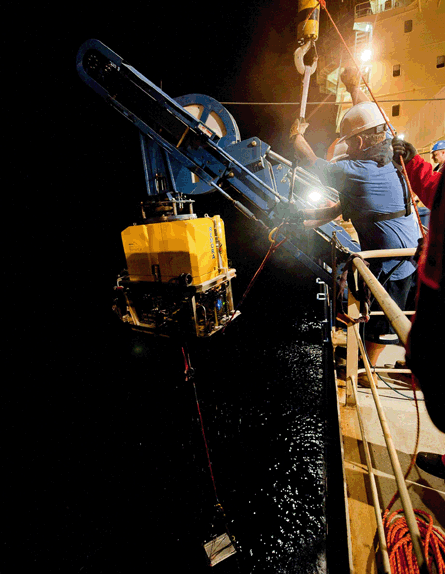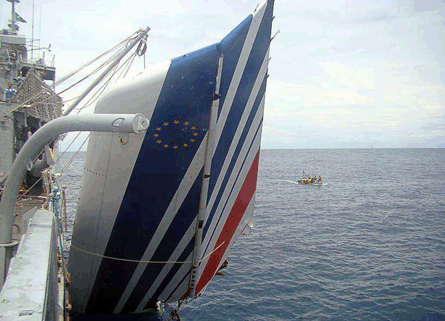Resilience is a word the airline pilot training world is going to hear often in the near future, to judge from this year's Royal Aeronautical Society (RAeS) flight training conference.
The term defines a quality airline flightcrew seem to be losing - witness a recent series of fatal loss-of-control/lack-of-control (LOC) commercial airline accidents, including Air France 447 and the Colgan Air Bombardier Q400 crash at Buffalo, New York. In all cases, the aircraft either had no technical fault at all or a minor one which should not have caused problems for a well-trained crew.
In the last 20 years almost all the business, technical and operational ground rules governing commercial aviation have radically altered, forced by changes in the market, the air traffic management and navigation environment and aircraft and avionic technology. Logically, these demand a change in training - but that change has not been delivered.
 |
|---|
© Rex Features AF447's cockpit voice recorder is retrieved from the Atlantic |
What has most affected the nature of pilots' work is the influence of low-cost carriers, which has brought radical change in many airlines' relationships with flightcrew. But what has most changed an airline's crew recruiting and management is the decline of the military as a provider of pilot skills.
LOSS OF CONTROL
There has been a loss of pilot exposure to anything other than pre-packaged flight planning, followed by automated flight. When circumstances are unusual or non-standard, lack of resilience can lead to fatal loss of control accidents, making LOC the biggest killer accident category this century - taking over from controlled flight into terrain in the last.
"Resilience" describes the human capacity to deal calmly and competently with the unexpected, particularly "black swan" occurrences - events that could been foreseen, or for which there are no checklist drills or standard operating procedures.
Resilience is not being delivered by today's normal training systems, the RAeS conference heard. The only pilots who have this quality tend to either have a military background or have been employed by an airline which has a selection procedure and recurrent training regime that goes well beyond the legal requirement - which most do not.
 |
|---|
The crash of a Colgan Air Bombardier Q400 in Buffalo, New York, was an example of a loss-of-control accident |
Robert Scott, of Scott Consulting, says the problem is built into the training system. The standard training template is set by pilot licensing and training regulations, which have not changed in their fundamentals since the 1950s. In addition, pilot attitudes to their employment are conditioned by a relatively new phenomenon - a broad-based Western airline withdrawal from accepting any part of the financial responsibility for the provision of a sustainable supply of quality pilots to fly their aircraft. Anthony Petteford, of Oxford Aviation Academy, recognises this as a major influence both on the kind of applicants for pilot training - those with access to funds - and the output from the training industry - pilots saddled with stressful levels of debt.
But there are also many causal factors for the reduction in crew competency, Scott argues, and some are cultural and societal. That starts with the "educational norm" in schools of "teaching young people to tests, instead of teaching them to competency", and this links seamlessly with the new Western pilot training norm, in which aspiring pilots self-select and self-finance for training to licence level - and in many cases purchase their type rating.
SOFT SKILLS FOCUS
"The intellectual and physical skills once required of the pilot have largely been replaced by an emphasis on 'soft skills' and automation management," Scott says. "The pilot who once cynically challenged sources of information now readily accepts information from a variety of sources, many computer-generated, without question." This system delivers ready-cooked, apparently cost-free ab initio flight crew with licences and ratings.
Twenty-plus years ago the military supplied the majority of airlines' flightcrew, but these new cost-free pilots have a radically different background. Nancy Graham, director of the Air Navigation Bureau at the International Civil Aviation Organisation (ICAO), admits that airlines are approaching ICAO over the issue of who should pay for airline training.
Many realise that the status quo is unsatisfactory and unsustainable, but none can afford to be the one which blinks first and starts sponsoring student pilots. Boeing has embraced the concept of pilot training as a university degree course, as both an academic and vocational course of study could attract government backing - if only in the form of tax breaks. And academic training provides a sounder knowledge base than a commercial distance-learning course designed to "cram" the student for the licensing examination's multiple-choice questions.
Concern for the industry's carelessness about future skilled employees is clear in programmes that ICAO and the International Air Transport Association (IATA) have set up in recent years, including ICAO's next-generation aviation professionals (NGAP) and IATA's training and qualification initiative (ITQI).
These are intended to modernise pilot and maintenance training to improve the effectiveness of qualification schemes and to identify the means to improve industry attractiveness - thus broadening the base of applicants for skilled air transport industry jobs - and to increase global standards and licensing harmonisation, to improve the industrial mobility of skilled professionals. ITQI is expected to launch by the end of the year. The European Aviation Safety Agency says its internal group on personnel training is developing an automation policy. Under the umbrella of the International Committee for Aviation Training in Extended Envelopes, several national aviation authorities seek ways of dealing with the LOC phenomenon.
 |
|---|
© Rex Features AF447 and the Colgan crash drew attention to pilot resilience, as the aircraft did not have technical problems that would necessarily cause problems for a well-trained crew |
ICAO is to publish its new training standards - ICAO Pans Training 2012 - next year, along with the unprecedented ICAO handbook of evidence-based training. But training delivered in the real world is framed not by ICAO but by national regulators - and at the RAeS there was no confidence of a rush to modify national programmes and syllabi.
NEW PHILOSOPHY
Under the new philosophy, the system to assess whether individuals are sufficiently competent to be issued with a licence is to be based on specified, measured actual performance - rather than completion of exercises in an approved syllabus without an actual mishap. This is a seismic shift of emphasis, and there is serious concern that the training changes required will challenge an industry chronically short of experienced instructors.
The concept of evidence-based training is not new. ICAO's PANS-TRG 2006 MPL (multi-crew pilot licence) defined specific competencies for instructors, as well as licensed pilots.
The MPL has been touted as offering the means by which a gradual globalisation of pilot licensing standards could be achieved. The RAeS reports that, since its 2010 training conference, one of the working party inputs has been the importance of threat and error management - a component lacking from traditional training, but included in the MPL.
Meanwhile the International Association of Flight Training Professionals is setting up a system for exchanging information on flight training best practices. It is to publish standards via Skybrary - a Eurocontrol-led aviation professionals' Wikipedia. The consensus at the RAeS was that the characteristics lacking in today's airline pilots are resilience and professionalism, two words which combined are arguably encompassed by the now rather less-used term "airmanship".
As for ensuring that air transport achieves the needed shifts in training priorities, the RAeS conference discerned a huge amount to be done - and quickly.
Hopes are pinned on four initiatives: the ITQI for type and recurrent training; the ICAO MPL for ab initio and evidence-based training; the RAeS ICATEE for unusual attitudes and extended envelope training and the RAeS/ICAO 9625 work on flight simulation training device qualification and standards to raise the integrity of training in simulators, especially at the edges of the flight envelope, while keeping costs in check.
Source: Flight International























